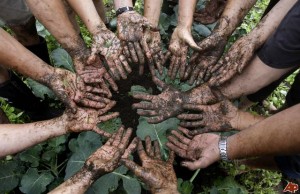Achieving a Sustainable Food System with Organic Farming

Despite a slight decline between 2009 and 2010, since 1999 the global land area farmed organically has expanded more than threefold to 37 million hectares, according to new research conducted by the Worldwatch Institute for its Vital Signs Online service. Regions with the largest certified organic agricultural land in 2010 were Oceania, including Australia, New Zealand, and Pacific Island nations (12.1 million hectares); Europe (10 million hectares); and Latin America (8.4 million hectares), write report authors Catherine Ward and Laura Reynolds.
Organic farming is now established in international standards, and 84 countries had implemented organic regulations by 2010, up from 74 countries in 2009. Definitions vary, but according to the International Federation of Organic Agriculture Movements, organic agriculture is a production system that relies on ecological processes, such as waste recycling, rather than the use of synthetic inputs, such as chemical fertilizers and pesticides.
“Although organic agriculture often produces lower yields on land that has recently been farmed conventionally, it can outperform conventional practices—especially in times of drought—when the land has been farmed organically for a longer time,” said Reynolds, a researcher with Worldwatch’s Food and Agriculture Program. “Conventional agricultural practices often degrade the environment over both the long and short term through soil erosion, excessive water extraction, and biodiversity loss.”
Organic farming has the potential to contribute to sustainable food security by improving nutrition intake and sustaining livelihoods in rural areas, while simultaneously reducing vulnerability to climate change and enhancing biodiversity. Sustainable practices associated with organic farming are relatively labor intensive. Organic agriculture uses up to 50 percent less fossil fuel energy than conventional farming, and common organic practices—including rotating crops, applying mulch to empty fields, and maintaining perennial shrubs and trees on farms—also stabilize soils and improve water retention, thus reducing vulnerability to harsh weather patterns. On average, organic farms have 30 percent higher biodiversity, including birds, insects, and plants, than conventional farms do.

Certifications for organic agriculture are increasingly concentrated in wealthier countries. From 2009 to 2010, Europe increased its organic farmland by 9 percent to 10 million hectares, the largest growth in any region. The United States has lagged behind other countries in adopting sustainable farming methods. When national sales rather than production are considered, however, the U.S. organic industry is one of the fastest-growing industries in the nation, expanding by 9.5 percent in 2011 to reach $31.5 billion in sales.
Sustainable food production will become increasingly important in developing countries, as the majority of population growth is concentrated in the world’s poorest countries. Agriculture in developing countries is often far more labor intensive than in industrial countries, so it is not surprising that approximately 80 percent of the 1.6 million global certified organic farmers live in the developing world. The countries with the most certified organic producers in 2010 were India (400,551 farmers), Uganda (188,625), and Mexico (128,826). Non-certified organic agriculture in developing countries is practiced by millions of indigenous people, peasants, and small family farms involved in subsistence and local market-oriented production.
Further highlights from the report:
- In 2010, the most recent year for which data are available, certified organic farming accounted for approximately 0.9 percent of the world’s agricultural land.
- Africa is home to 3 percent of the world’s certified organic agricultural land, with just over 1 million hectares certified. Asia has 7 percent, with a total of 2.8 million hectares.
- Despite a decline in organically farmed land in China and India between 2009 and 2010, India’s export volume of organic produce increased by 20 percent.
More: http://www.worldwatch.org/achieving-sustainable-food-system-organic-farming


